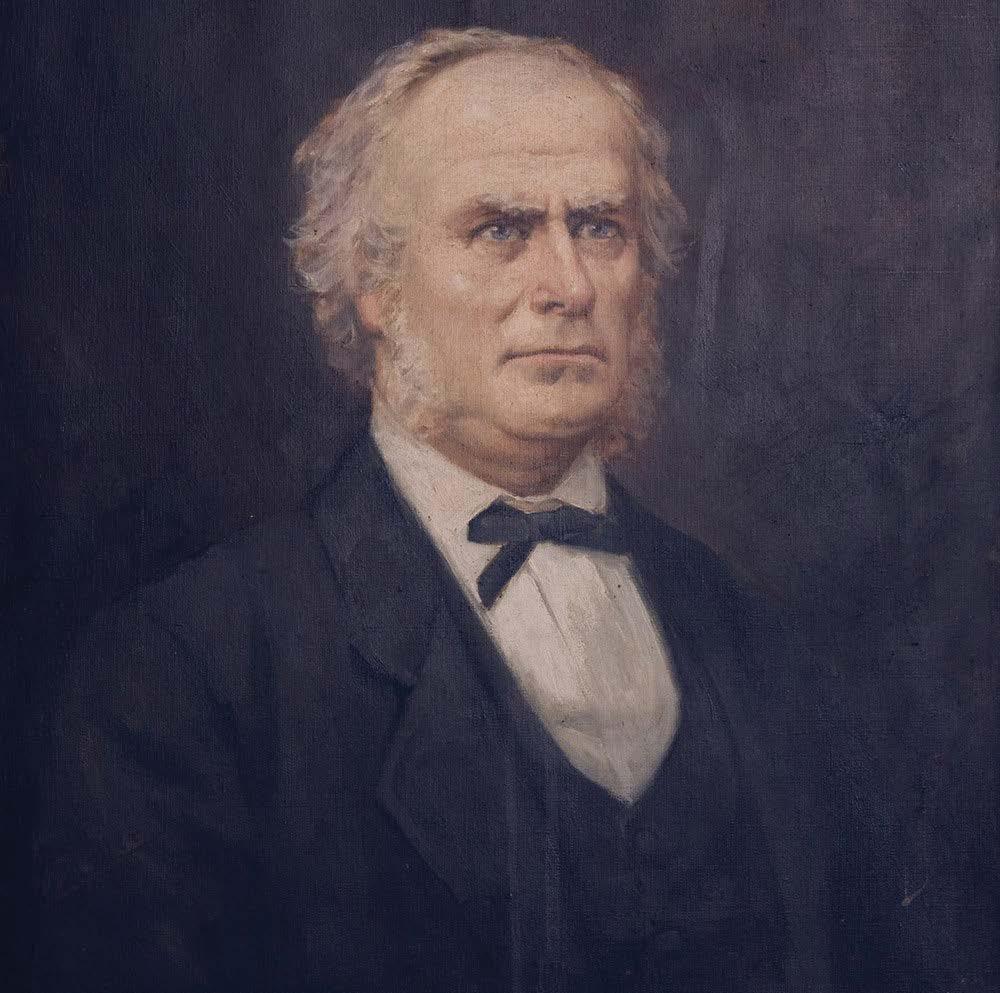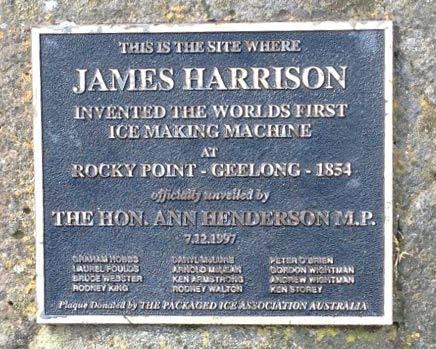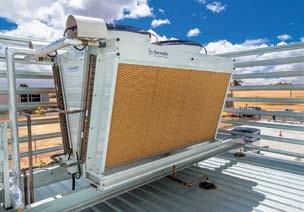
11 minute read
Homage to Harrison
Sir Don Bradman has one, so does Saint Mary McKillop, Norman Lindsay, and Bert Hinkler. So why isn’t the story of James Harrison, the father of refrigeration, told in a museum? As Sean McGowan reports, one dedicated group is working towards this goal.
Imagine the heady days of colonial life – a time when industrialisation was transforming the Australian economy and bringing the world a step closer.
Advertisement
A Scotsman by birth and printer by trade, James Harrison found a country still 64 years shy of federation when he emigrated to Sydney in 1837.
The then 21-year-old, having completed a printing apprenticeship in London, responded to an advertisement by London-based company Tegg & Co. for a compositor to join its Sydney office.
Thus began Harrison’s contribution to Australia’s print media. Following contributions to Tegg & Co.’s short-lived Literary News, and a stint with the Sydney Herald, Harrison headed south to Melbourne where he found work as a compositor with the Port Phillip Patriot. The Patriot was one of many print titles established by the city’s founding father, John Pascoe Fawkner. After ascending to the role of editor, Harrison was sent south-west to Geelong where he established another of Fawkner’s titles, the Geelong Advertiser, in 1840. He would go on to own the Advertiser by September 1842. A man of many talents and interests, Harrison played a distinguished role in public office too – first as an inaugural member of Geelong’s first town council in 1850, and then as a representative of the Geelong and Geelong West electorates in the Victorian Parliament.
But it was Harrison’s interest in science that led him to his perhaps his greatest achievement.
It started when he recognised there might be other uses for sulphuric ether than just for cleaning the removable type on his printing press. Experiments with the ether and a whorl coil from a heating apparatus followed. He was onto something, and after joining forces with blacksmith John Scott, the duo established an ice works on the banks of the Barwon River at Rocky Point (more about that location later). Harrison’s ether-vapour compression refrigeration system used a compressor to force ether through a condenser where it cooled and liquefied. The liquefied gas was then circulated through refrigeration coils, and vapourised again, cooling down the surrounding machine.
In 1854, the first mechanically-made ice was made, and within a year Harrison had submitted his first patent titled Refrigerating Machine.
According to Dr Roy Lang’s book James Harrison – Pioneering Genius, Harrison named ether or alcohol as the refrigerants and gave special directions for the use of ammonia or other gaseous solutions.

Harrison received medals of commendation from exhibitions in London (1863) and Melbourne (1873) where he showed his refrigeration machines. He also won a prize from the Geelong and Western District Agricultural and Horticultural Society for his “Self-acting beer preserver” in 1863.
“The purposes were the manufacture of ice from water, either pure or salt; the preservation of provisions by congelation; the cooling of buildings; and generally for the reduction of temperature wherever required. “…this 1855 machine costing over £1,000 had a capacity of 3,050kg of ice per day and was driven by a 3.5 horsepower engine.” Harrison’s concept would come to be the forerunner of our extensive HVAC&R industry.
Committed to improving his machine, Harrison set out for London where he patented both his machine and the process, and sought steam engineering expertise. There, he commissioned engineers Siebe & Co. to build a new version of his original machine at Rocky Point at a cost of £1,200.
The first commercial Harrison-Siebe refrigeration machine was sold in 1857 to a London brewery. Further improvements and sales quickly followed and by 1861, Harrison’s refrigeration machines were in use around the world.
Returning to Melbourne with a new 10hp (7.457kW) machine in tow, Harrison began producing slabs and blocks of ice of various weight and in 1859, founded the Victoria Ice Works in Franklin Street. A year later, he co-founded the Sydney Ice Company with another machine.
FINDING RECOGNITION
Although Harrison’s invention did not bring him sustained personal financial success, his creativity and ingenuity should always be remembered.
Today he is mainly recognised by those in the HVAC&R industry as the father of refrigeration. AIRAH’s head office in Melbourne – the James Harrison Centre – is named in his honour.
So too is the highest honour AIRAH can bestow on an individual – the James Harrison Medal, one of the highlights of the Institute’s annual awards.
Then there’s the Harrison Bridge over the Barwon River in Geelong, and a bronze marker on the river’s bank recognising the site of that historic ice works. But it remains somewhat of a surprise to find that Harrison’s story is not more widely known or told – or that his name is not held among the most adored of pioneering Australians.
“It says something about our society that there is so little acknowledgement of this great figure,” former Victorian Premier John Brumby once said of Harrison and his work.

This plaque was unveiled at Rocky Point in 1997.
Every school student in the country should know his name.

future-proof solutions
FOR REFRIGERATION & COOLING TECHNOLOGY

CO2 evaporator CO2 gas cooler with adiabatic pads


NH3 insulated cooler
NH3 evaporative condenser
customized evaporators for DX and pumped NH3 and CO2 insulated coolers for easy high utilization of the room space and convenient maintenance air cooled and adiabatic condensers as well as gas coolers evaporative condensers with stainless-steel-coils
An architect’s impression of the proposed James Harrison Museum at Rocky Point, Geelong.
MUSEUM-WORTHY
For more than 30 years, a group of business leaders, historians and interested members of the Geelong community have campaigned long and hard for the work of James Harrison to find a dedicated home.
It started in 1988 when the Geelong Rotary Club raised $5,000 to have a giant Linde ammonia compressor and flywheel installed in the city’s Steampacket Gardens.
Originally used in the Jackson Freezing Works in the early 1900s, where it produced 150 tonnes of ice an hour, the compressor and flywheel worked on the same principle as Harrison’s machine.
After the idea failed to gain approval, a committee of members of the Geelong Regional Commission was formed to carry the proposal of a museum forward.
Soon after, James Harrison Museum Inc. was established.
Led by the late Bruce Webster, a local engineer and commissioner on the Geelong Water Board, the new committee set about completing all the necessary groundwork to create the museum, including repairs and restoration of the historic machinery that would be part of the exhibit. With an appropriate site at Rocky Point identified, work commenced on architectural plans for the James Harrison Museum, incorporating an information and interpretation centre, with an estimated build cost of $1.75–$2.25 million.
In 1994, local lawyer Graham Hobbs became chairman of the committee, ably supported by a team of members including Webster and among others, the late Jim Harrison – James Harrison’s grandson.
Former editor of the Geelong Advertiser, Daryl McLure, joined the committee as Vice Chairman in 1996. The committee unveiled the James Harrison memorial plaque at Rocky Point with local MP the Hon. Ann Henderson MLA, a year later.
The James Harrison Museum Appeal was also launched to raise funds for the multi-million dollar project.
The appeal raised some $132,000 – including funding from a Federal Government grant, and pledges of financial support from the Australian HVAC&R industry including AIRAH. The in-kind work of committee members was valued at $40,000. “I thank AIRAH and its members for that support, as the industry would be poorer without the inspiration of James Harrison,” says Hobbs.
Despite the committee’s best efforts, it fell well short of the funding required to build and maintain the museum. Faced with a lack of support from local and state governments, the committee eventually disbanded in 2012.
At this time, Hobbs assumed the role of repository of all records. And there are many.
Parts of the historic machinery the committee managed to obtain over the years – lovingly restored by the committee’s engineering members in a shed donated by Tollport at Corio Quay – have been relocated to Ceres, not far from Geelong.
A model of Harrison’s refrigeration machine from around 1857 – the only non-American object to have been on display at the Smithsonian Institute in Washing DC, USA – is now under the stewardship of Museums Victoria at Scienceworks.

CELEBRATING AUSSIE INVENTIONS
James Harrisons’ story was told in the eight-part documentary series, Aussie Inventions that Changed the World – a program produced by SkinnyDip Pictures and Northern Pictures in 2019.
Featuring interviews with local Harrison aficionados Graham Hobbs and Daryl McLure, it is available to stream on Foxtel’s History Channel.

KEEPING THE FAITH
Almost 10 years has passed since the committee for the James Harrison Museum Inc. was disbanded, but the passion remains among those who fought long and hard for the project to succeed.
Both Hobbs and McLure are enthusiastic to share Harrison’s story – the latter having written about the topic on numerous occasions.
“In recent years there has been a renewed interest in Harrison’s pioneering work in refrigeration with Sydney ABC broadcaster Richard Glover and a film production crew visiting Geelong to tell his story,” wrote McLure in the Geelong Advertiser in 2020.
Is there hope for a James Harrison museum in the future? Maybe.
Visit the Eastern Cemetery at Geelong and you can find Harrison’s final resting place. Pointedly, the headstone reads: One soweth, another reapeth.
Just as others benefited from Harrison’s work, perhaps a new generation of mechanical and refrigeration engineers and mechanics might one day fulfil the dream of creating a dedicated museum honouring his work.
Hobbs says he would be only too glad to point them in the right direction.
“Each time a person opens the fridge, we should say ‘Thanks James’,” says Hobbs. ■
Graham Hobbs and I told our story, but our committee no longer existed.
MORE TO THE STORY
To read more of Harrison’s story, including his role in the race to ship frozen meat to London, visit AIRAH’s Centenary website at www.airah100.org.au/jamesharrison
GET IN ON THE CELEBRATIONS!
Not everyone knows that Geelong was declared a UNESCO City of Design in 2017. This designation is underpinned by the city’s history of innovation as an industrial and wool centre.
It was the location for over 60 inventions (or inventors), some being world-firsts – including James Harrison’s ice-making machine – that would see the city become a leader in architectural and wool education, research and technology.
Now, every year, the City of Greater Geelong celebrates Geelong Design Week. This year it will be held from March 18–21 with the theme “unpredictable”.
The event will demonstrate resourceful adaptation that turns challenges into opportunities, and celebrates clever and creative human environment design that turns obstacles into building blocks.
Fittingly, James Harrison’s work will be celebrated thanks to the efforts of the Geelong and Region Branch of the National Trust (GRBNT). As a keen supporter of Geelong’s UNESCO designation and the week-long event, the GRBNT annually promotes and features heritage-related events as part of the program.
In 2021, the GRBNT has chosen to feature James Harrison’s career from printer-to-journalistto-inventor presenting:
■ An online streamed event James Harrison –
Geelong inventor, editor, and entrepreneur on Friday, March 19 at 6.55pm (timed to allow Harrison’s compatriots in Scotland to participate). This session will be moderated by Associate Professor Dr. Meghan Kelly, of Deakin University’s Design department.
For bookings, go to www.trybooking.com/BMYIK ■ An exhibition, James Harrison’s Momentous
Achievements: Models, Medals and
Memorabilia, held from March 20–28.
It will show a timeline of Harrison’s amazing life, a model of one of his early machines, an early household refrigerator and medals and tributes that he earned.
For bookings, go to www.trybooking.com/BMZPQ Both events will be held at the National Trust-owned heritage property, Barwon Grange, near Rocky Point.
Members of the former James Harrison Museum Inc. committee are contributing their knowledge, supported by a curator and designer.
“The GRBNT sub-committee hopes, through these events, to raise James Harrison’s profile in Geelong and to advocate for a permanent place to commemorate his life and works,” says Lex Chalmers OAM, chair of the GRBNT City of Design Sub-Committee.
“As an untrained – but expert – designer, engineer and inventor, he’s the perfect subject for the Geelong UNESCO City of Design to celebrate.”
Later in the year, the GRBNT hopes to place a commemorative plaque near James Harrison’s last dwelling at Point Henry. ■
WOULD YOU LIKE TO KNOW MORE?
To subscribe for booking information about the full Geelong Design Week 2021 program visit www.geelongcityofdesign.com.au/geelong-design-week To learn more about the work of the GRBNT, visit www.nationaltrust.org.au/branches-vic/geelong-region-branch
www.regulatorautomation.com.au




For all your HVAC product, design, installation and servicing needs: Call (02) 9804 6366 or visit: www.regulatorautomation.com.au



CC-HV&R-039
BUILDING AUTOMATION
Solutions for Pressure, Temperature, Air Quality, Flow and Thermal Energy Monitoring
DWYER INSTRUMENTS, PTY. LTD. 02 4272 2055









